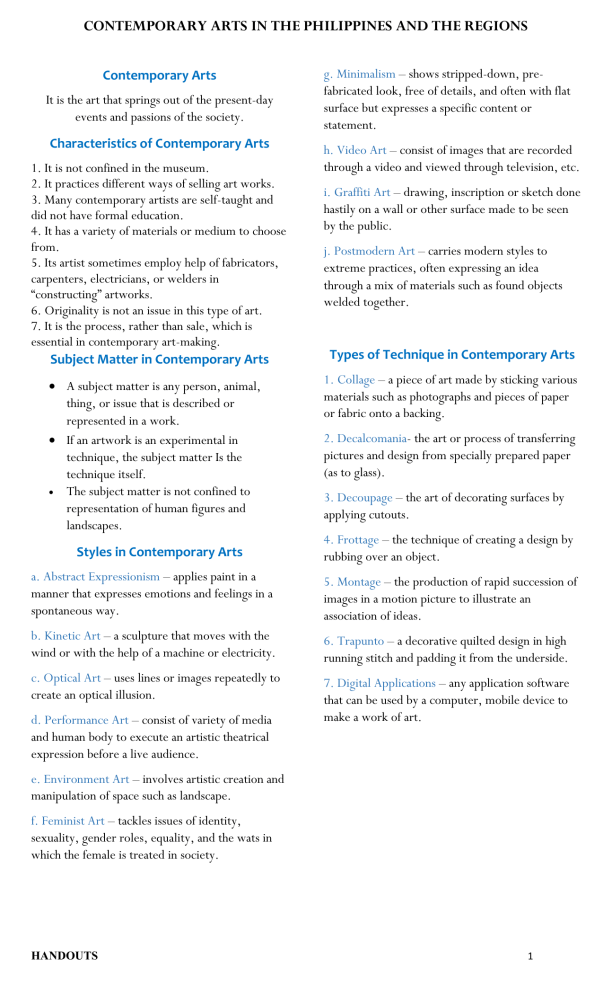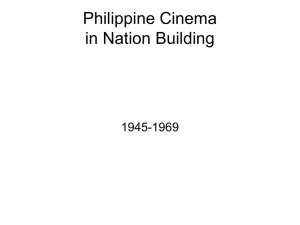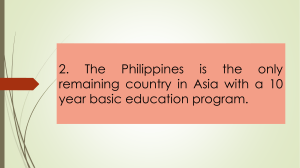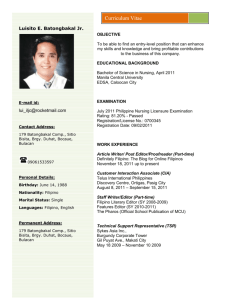
CONTEMPORARY ARTS IN THE PHILIPPINES AND THE REGIONS Contemporary Arts It is the art that springs out of the present-day events and passions of the society. Characteristics of Contemporary Arts 1. It is not confined in the museum. 2. It practices different ways of selling art works. 3. Many contemporary artists are self-taught and did not have formal education. 4. It has a variety of materials or medium to choose from. 5. Its artist sometimes employ help of fabricators, carpenters, electricians, or welders in “constructing” artworks. 6. Originality is not an issue in this type of art. 7. It is the process, rather than sale, which is essential in contemporary art-making. Subject Matter in Contemporary Arts A subject matter is any person, animal, thing, or issue that is described or represented in a work. If an artwork is an experimental in technique, the subject matter Is the technique itself. The subject matter is not confined to representation of human figures and landscapes. Styles in Contemporary Arts g. Minimalism – shows stripped-down, prefabricated look, free of details, and often with flat surface but expresses a specific content or statement. h. Video Art – consist of images that are recorded through a video and viewed through television, etc. i. Graffiti Art – drawing, inscription or sketch done hastily on a wall or other surface made to be seen by the public. j. Postmodern Art – carries modern styles to extreme practices, often expressing an idea through a mix of materials such as found objects welded together. Types of Technique in Contemporary Arts 1. Collage – a piece of art made by sticking various materials such as photographs and pieces of paper or fabric onto a backing. 2. Decalcomania- the art or process of transferring pictures and design from specially prepared paper (as to glass). 3. Decoupage – the art of decorating surfaces by applying cutouts. 4. Frottage – the technique of creating a design by rubbing over an object. a. Abstract Expressionism – applies paint in a manner that expresses emotions and feelings in a spontaneous way. 5. Montage – the production of rapid succession of images in a motion picture to illustrate an association of ideas. b. Kinetic Art – a sculpture that moves with the wind or with the help of a machine or electricity. 6. Trapunto – a decorative quilted design in high running stitch and padding it from the underside. c. Optical Art – uses lines or images repeatedly to create an optical illusion. 7. Digital Applications – any application software that can be used by a computer, mobile device to make a work of art. d. Performance Art – consist of variety of media and human body to execute an artistic theatrical expression before a live audience. e. Environment Art – involves artistic creation and manipulation of space such as landscape. f. Feminist Art – tackles issues of identity, sexuality, gender roles, equality, and the wats in which the female is treated in society. HANDOUTS 1 CONTEMPORARY ARTS IN THE PHILIPPINES AND THE REGIONS The Order of National Artist -the highest national recognition given to Filipino individuals who have made significant contributors to the development of the Philippine arts. NCCA -National Commission for Culture and Arts CCP -Cultural Center of the Philippines II. THE NATIONAL ARTIST A. ARCHITECTURE 1. National Capital Region a. Pablo S. Antonio (1976) -born in Binondo, Manila -Pioneered Modern Filipino Architecture -emphasizes function before elegance MAJOR WORK: Far Eastern University b. Juan F. Nakpil (1973) -born in Quiapo, Manila -known as the “Dean of Filipino Architects” -espoused architecture reflective of Philippine traditions and culture MAJOR WORKS: Rizal Theatre c. Ildelfonso P. Santos (1981) -born in Malabon, Manila -the “Father of Philippine Landscape Architecture” HANDOUTS 2 CONTEMPORARY ARTS IN THE PHILIPPINES AND THE REGIONS MAJOR WORKS: Mt. Malarayat Golf and Country Club in Lipa 2. REGION 3 – CENTRAL LUZON a. Jose Maria V. Zaragosa (2014) - from Guagua, Pampanga -famous for modern ecclesiastical architecture MAJOR WORKS: Meralco Building 3. REGION 18 – NEGROS ISLAND a. Leandro V. Locsin (1990) - born in Silay, Negros Occidental - used themes of floating volume, duality of light and heavy MAJOR WORKS: The palace of Sultan Brunei B. VISUAL ARTS 1. NATIONAL CAPITAL REGION a. Fernando Amorsolo (1972) - born in Paco, Manila - the “Grand Old Man of Philippine Art” - famous by his backlighting technique MAJOR WORKS: Planting Rice b. Cesar Legaspi (1990) - a pioneer “Neo-Realist” of the country - use geometric fragmentation technique MAJOR WORKS: Gadget I and Gadget II c. Hernando Ocampo (1991) - from Sta. Cruz, Manila - his canvases evoked the lush Philippine Landscape MAJOR WORKS: Genesis d. Arturo Luz (1997) - established the Luz Gallery -professionalized the art gallery as an institution MAJOR WORKS: Bagong Taon e. Jose T. Joya - pioneered abstract expressionism in the Philippines -creating an authentic Filipino abstract idiom that transcended foreign influences MAJOR WORKS: f. Benedicto Cabrera (2006) -from Malabon -the best-selling painter of his generation MAJOR WORKS: Sabel g. Federico Aguilr Alcuaz (2009) - from Sta. Cruz, Manila - known for his gestural paintings in acrylic and oil MAJOR WORKS: h. Francisco Coshing (2014) HANDOUTS - born in Buting, Pasig - “the King of Komiks” and “Dean of Filipino illustrators” MAJOR WORKS: 2. REGION 1 – ILOCOS REGION a. Victorio Edades (1976) - grew up in Barrio Bolosan, Dagupan, Pangasinan - the “Father of Modern Philippine Painting” - colors were dark and somber MAJOR WORKS: The Sketch 3. REGION 3 – CENTRAL LUZON a. Guillermo Tolentino (1973) - born in Malolos, Bulacan -the “Father of Philippine Arts” MAJOR WORKS: Bonifacio Monument and UP Oblation b. Vicente Manansala (1981) - from Macabebe, Pampanga - a cubist Painter and illustrator MAJOR WORKS: Banaklaot 4. REGION 4A – CALABARZON a. Carlos “Botong” Francisco (1973) - from Angono - he revived the forgotten art of mural MAJOR WORKS: Magpupukot 5. REGION 6 – WESTERN VISAYAS a. J. Elizalde Navarro (1999) - Born in Antique -a versatile artist MAJOR WORKS: I’m Sorry Jesus 6. REGION 7 – CENTRAL VISAYAS a. Napolen Abueva (1976) - a native of Bohol - “Father of Modern Philippine Sculpture” - He has utilized almost all of the materials from hard wood MAJOR WORKS: Kaganapan 7. REGION 11 – DAVAO a. Ang Kiukok - born in Hwa Shing - he fused influences from cubism, surrealism, and expressionism MAJOR WORKS: Geometric Landscape 8. REGION 15 – UTONOMOUS REGION OF MUSLIM MINDANAO a. Abdulmari Asia Imao (2006) - a native of Sulu - sculptor, painter, photographer and etc. of Philippine Muslim art and Culture MAJOR WORKS: Industry Bass Mural C. FASHION DESIGN 1. REGION 14 – CORDILLERA 3 CONTEMPORARY ARTS IN THE PHILIPPINES AND THE REGIONS ADMINISTRATIVE REGION a. Ramon Valera - from Abra - performing his magical seminal innovations on the Philippine terno D. LITERATURE 1. NATIONAL CAPITAL REGION a. Jose Garcia Villa (1973) - one of the finest Filipino poet - introduced reversed consonance rhyme scheme including the comma MAJOR WORKS: Footnote to Youth b. Nick Joaquin (1976) - most distinguished Filipino writer in English writing - Enrich the language with critics coining “Joaquinesque” MAJOR WORKS: Manila: My Manila HANDOUTS 4




